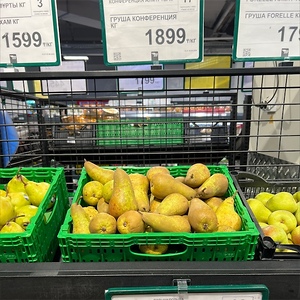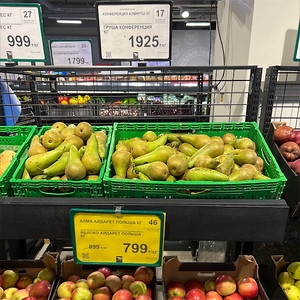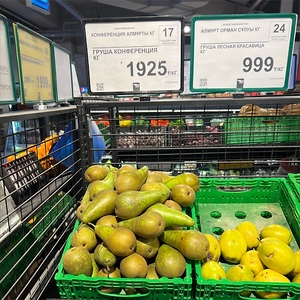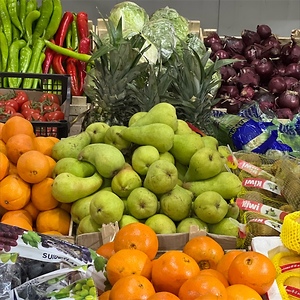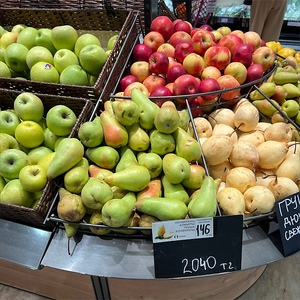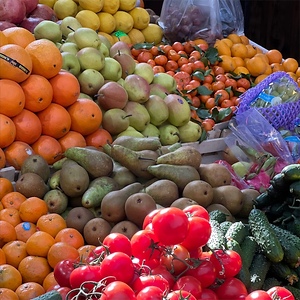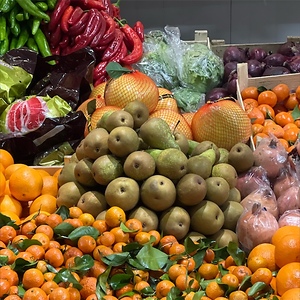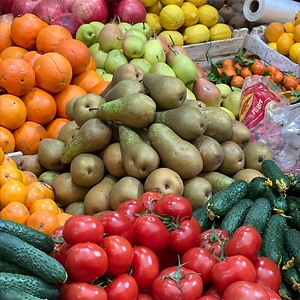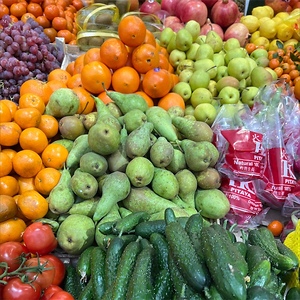

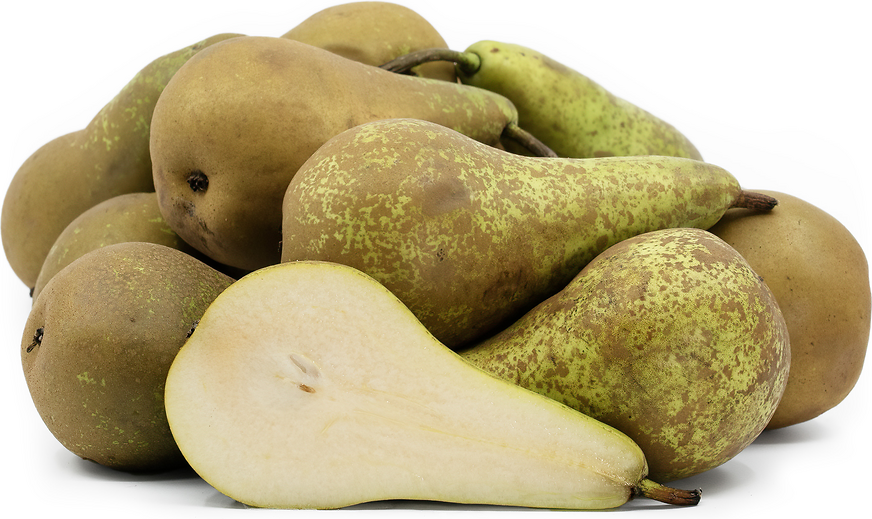
Conference Pears
Estimated Inventory, lb : 0
Description/Taste
Conference pears are a distinctly shaped varietal with an elongated nature and vary in size, depending on cultivation conditions, averaging 4.5 to 8 centimeters in diameter. Most Conference pears are larger than other European commercial varieties and have a bulbous, curved base tapering to a slender, long neck, creating a bottle-like shape. The pears are topped with a fibrous, woody, dark brown stem, and the skin is thick, textured, and taut. Conference pears ripen from green to pale yellow hues and are often enveloped in mottling of sandy, rough brown russet. Underneath the skin, the cream-colored to ivory flesh is dense, aqueous, and fine-grained. When consumed slightly underripe, Conference pears have a firm, crunchy, and chewy flesh. As they mature, the flesh softens into a melting, buttery, soft, and tender consistency. Ripe Conference pears may also exhibit a faint, pink-hued center. Conference pears are edible at multiple stages of maturity and have some acidity when younger and firmer. Mature fruits have sugar levels ranging from 12.5 to 14.5 degrees Brix, developing a sweet, fruity, and floral taste with perfumed, muscat-like nuances.
Seasons/Availability
Conference pears are available in the fall and winter. They are harvested between September and early November and professionally stored for sale throughout the winter, sometimes into January.
Current Facts
Conference pears, botanically classified as Pyrus communis, are a famous European variety belonging to the Rosaceae family. The mid-season pear was developed and released in the late 19th century and quickly became one of the most commercially produced pears throughout Central and Western Europe. Conference pears grow on trees reaching four meters in height and are a hardy, tolerant cultivar. The variety is disease resistant, especially to pear scab, and produces reliable, large crops. Conference pears arose during a time when the European pear industry was struggling to grow a commercial pear that could represent many different regions. Conference pears were adaptable and were especially favored for their fragrant flesh, extended storage capabilities, and ability to be eaten in multiple stages of ripeness. Since their release, Conference pears have been one of the most common and stable pear varieties seen in European commercial markets. The variety is treasured for its versatility and is sold fresh for a wide array of raw and cooked culinary preparations.
Nutritional Value
Conference pears are a source of potassium to balance fluid levels and replenish electrolytes in the body, as well as vitamins C and K to strengthen the immune system while aiding in faster wound healing. Pears also provide fiber to stimulate and support the digestive tract, iron to develop the protein hemoglobin for oxygen transport through the bloodstream, calcium to protect bones and teeth, magnesium to control nerve functions, and other nutrients, including folate, copper, and riboflavin. Pears contain antioxidants to assist in reducing inflammation in the body and guard the cells against the damage caused by free radicals.
Applications
Conference pears have a sweet, fruity, and floral flavor suited for fresh and cooked preparations. The variety can be consumed at multiple stages of maturity and will have a crunchy to melting texture when eaten straight out of hand. Conference pears are sliced and served on cheese boards, tossed into salads, or mixed into fruit bowls. In Europe, Conference pears are adaptable and can be used in any preparation calling for pears. They are also used as a fresh topping over parfaits, chia seed pudding, and oatmeal or blended into smoothies and fruit juices. In addition to raw preparations, Conference pears can be poached, roasted, baked, or stewed. The fruits are popularly cooked in red wine, rum, or rich chocolate sauces and are often baked into desserts with crushed nuts and phyllo dough. Cooked Conference pears can be sprinkled in a citrus zest for enhanced flavoring, served on top of pizza variations, or coated in warm spices as a decadent dessert. They can also be added to tarts, roasted in honey, baked into bars, or served with vanilla ice cream. Conference pears complement nuts such as walnuts, almonds, and pecans, maple syrup, vanilla, chocolate, and spices, including cinnamon, cloves, cardamom, and ginger. Whole, unopened Conference pears will keep for 1 to 4 weeks at room temperature, depending on their degree of ripeness at the point of purchase. Once ripe, Conference pears should be stored in a cool and dark location, mainly the refrigerator, and in proper storage they can keep for several months.
Ethnic/Cultural Info
Conference pears were named after their introduction to commercial growers through two conferences in the late 19th century. During this time, the European pear industry struggled to compete with the rising availability of North American pear imports with the rise of refrigerated steamships and railways. Faster access to fresh fruits and vegetables allowed varieties from the United States and Canada to be transported to Europe and sold commercially. By 1887, there was even a Foreign Fruit Exchange occurring at the Convent Garden Market in London, England. British growers decided to select one variety for increased commercial production to compete against the North American fruits. In 1885, the Royal Horticultural Society held a National Pear Conference at their vineyard gardens in Chiswick and later had an Apple and Pear Conference in 1888. Over 615 pear varieties were displayed at the National Pear Conference, and it was considered one of the largest exhibitions of pears. Each pear was marked with its name and growing information, including climate, crop yields, rootstock, soil, and season. Conference pears won top prizes in both of the mentioned events, and the pear’s breeder decided to name the fruit after the conferences it was recognized through, acquiring the conference moniker around 1895.
Geography/History
Conference pears were developed in England by nurseryman Thomas Francis Rivers in the 19th century. The variety was an open-pollinated seedling discovered in Rivers’ nursery in Sawbridgeworth, Hertfordshire, England, in 1884 and is thought to be a descendant of Leon Leclerc de Laval pears, an heirloom Belgium cultivar. After noticing the new variety, Thomas Francis Rivers introduced the pear to the European pear industry through two conferences in 1885 and 1888. Conference pears won first prize at both the National Pear Conference in 1885 and the Apple and Pear Conference in 1888 and were selected as a new variety to reinvigorate the commercial pear industry in Europe. The variety was first commercially planted in 1895 through grower Talbot Edmonds in Allington, a village in Kent, England. Over time, the variety quickly spread in production and became a favored commercial pear throughout the United Kingdom and other Central and Western European regions. In 1885, Conference pears were awarded a First Class Certificate by the Royal Horticultural Society and an Award of Garden Merit in 1993, two prestigious recognitions honoring the variety’s quality and growing characteristics. The variety was also selectively improved by breeders in the 1990s, allowing the pears to adapt to modern markets and maintain their dominance in European commercial markets. Today, Conference pears are grown throughout Europe, with concentrated production in Belgium, the Netherlands, England, France, Spain, and Italy. The variety is sold domestically in fresh markets, supermarkets, and through wholesalers and is exported to countries in Asia, including Singapore, Hong Kong, and China. Conference pears are also grown in smaller quantities in the United States and in home gardens worldwide.
Recipe Ideas
Recipes that include Conference Pears. One
Podcasts



